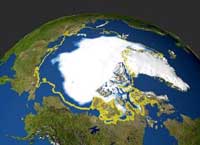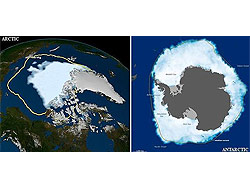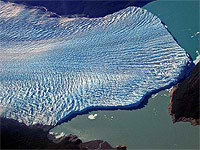Un crecimiento nada desdeñable el que reflejan las cifras “oficiales” admitidas por la NASA (que, por cierto, coinciden con las que publicábamos en Libertad Digital a mediados de septiembre), ya que la agencia americana reconoce que en el momento en el que el hielo alcanzó su mínimo veraniego la superficie que cubría era de 5,36 millones de kilómetros cuadrados, 690.000 más que en 2008 y más de un millón superior a la de 2007.
Sorprendentemente, la NASA califica este aumento como “ligero” (el término que usan es slight recovery, ligera recuperación) aunque la superficie helada ha crecido sólo este año en un área sensiblemente mayor que la extensión de toda España, que es de poco más de 500.000 kilómetros cuadrados.
Del mismo modo, la agencia americana recalca que se trata del tercer año en el que la capa de hielo es menor, si bien conviene no olvidar que la serie histórica se remonta tan sólo a 1979, es decir, solo 30 años.
La NASA señala que ese aumento se ha producido a pesar de que la temperatura en la superficie del agua “se ha mantenido por encima de lo normal”, aunque no aclara qué considera normal o qué temperaturas medias le permiten hacer esta afirmación, pero que la capa de hielo polar se ha derretido menos por las “condiciones más frías” resultado, sobre todo, de un cielo más nublado durante el verano.
Noticia publicada en Libertad Digital (España)
Enlaces a sitios |
| |
Climbing Magazine Climbing Magazine"s Web site contains more than 30 years of rock and ice climbing news, climber profiles, technical information, and gear reviews. You"ll also find message boards, photo galleries, and classifieds
| Cold Regions Bibliography Between 1999 and 2000, this project was carried out under an Interagency Agreement between the Federal Research Division of the Library of Congress and the U.S. Army Cold Regions Research and Engineering Laboratory (CRREL).
|
Descent into the Ice A tem of "glacionauts" ventures into a labyrinth of unexplored anda hazardous glacier caves on France"s Mont Blanc
| Glacier and Permafrost Hazards in Mountains – GAPHAZ Scientific Working Group of the International Association of Cryospheric Sciences (IACS) and the International Permafrost Association (IPA). Department of Geosciences University of Oslo
|
Glacier hazards The experience and data on glacier disasters in Switzerland has been systematically collected in the past two decades, and historical sources were analyzed.
| Glacier Hazards From Space Glacier hazards represent a continuous threat to human lives and infrastructure in mountain regions.
|
Glacier Hazards in Perú The floods, known in Perú as aluviónes, come with little or no warning and are composed of liquid mud that generally transports large rock boulders and blocks of ice.
| Glaciers and Glacier Hazards Glaciers and Glacier Hazards Glaciers and Ice Sheets and Volcanic Eruptions, USGS/Cascades Volcano Observatory, Vancouver, Washington
|
Glaciers online Glaciers online offers photos and summary explanations concerning glaciers from all over the world. The primary goal of our project is to enrich and stimulate the teaching of Earth Science and Physical Geography, in particular glaciology.. Jürg Alean & Mi
| Global Land Ice Measurements from Space GLIMS (Global Land Ice Measurements from Space) is a project designed to monitor the world"s glaciers primarily using data from optical satellite instruments, such as ASTER (Advanced Spaceborne Thermal Emission and reflection Radiometer).
|











 Imagen: Agencias / Internet
Imagen: Agencias / Internet





